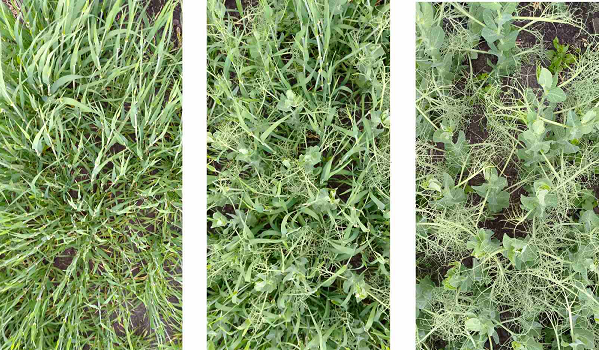Is There a Future for Intercropping?
Modern agriculture is focused on achieving
maximum crop yields and high-quality indicators. Realizing the potential for
productivity is possible by eliminating competition with other species and
providing plants with all the necessary resources in balance. This strategy is
called intensive crop
production. Unfortunately, such a strategy leads to
reduced biodiversity, the one-sided depletion of nutrients, soil degradation,
and contamination with xenobiotics, which can have negative ecological and
biological consequences for the environment, subsequent crops, humans, and
animals. Alongside intensive technologies, ecological, biological, and
regenerative practices are developing, with the aim of preserving the
environment, improving biodiversity, and achieving a certain level of
agricultural productivity and product quality.
Organic
farming methods have their advantages, but in certain aspects, they represent a
long-term approach. Achieving a stable biocenosis after transitioning from
intensive to organic farming requires a comprehensive strategy for developing
such a system. Typically, in the first year after discontinuing the use of
chemical plant protection products, crops are more susceptible to diseases,
become prime targets for pests, and weeds experience a "burst of
freedom." Is there a way to transition to organic technologies more easily
and painlessly?
According
to agricultural laws, no ecological niche can remain vacant; if a crop does not
occupy all niches, weeds will. Some crops can successfully compete with weeds
without the use of herbicides. This trait is common among many cereal crops,
with barley being the champion in this regard. Barley develops quickly in the
spring, matures rapidly, and has a high yield potential. Despite these
positives, barley has a lower protein content compared to other cereals, making
it less valuable as feed compared to wheat and corn. However, one of barley's
strengths is its ability to coexist with other cultivated species that do not
occupy its ecological niche.
Historically,
peas, beans, and vetch have been similar to barley in terms of environmental
and biological requirements, making them suitable for mixed cropping. These
crops are also excellent for balancing feed content with protein, both in green
mass, straw, and as concentrated feed.
So, why
might mixed cropping be the answer to the challenges of transitioning to
organic technologies?
1.
Complete Occupation of Ecological Niches: The legume-cereal complex occupies all available
ecological niches in the first half of the growing season. Weeds in mixed crops
either do not emerge or their presence does not significantly impact
productivity. By the time legumes begin to mature, weeds may start to appear,
but in mixed crops, cereals occupy these niches and also start to mature. With
the right variety selection, the ripening periods are synchronized, allowing
for simultaneous harvesting.
2. Enhanced
Biodiversity: This
type of coexistence increases biodiversity, promoting the presence of predatory
insects and mites that feed on pests. The absence of insecticides allows these
beneficial populations to increase, leading to fewer phytophagous insects in
subsequent seasons.
3. Improved Nitrogen Fixation: Legumes are capable of fixing atmospheric nitrogen in the rhizosphere, with excess nitrogen being absorbed by the cereal component. Barley, which is very "greedy" for nitrogen, benefits from the increased efficiency of nitrogen-fixing bacteria, even though they are now working for two plants. Numerous studies have shown that mixed cropping results in higher nitrogen assimilation than monocropping legumes. This nitrogen is assimilated into the vegetative mass and seeds, making the produce from mixed crops suitable for human consumption, animal feed, and as raw material for other byproducts.
4. The
Simplicity of Separating the Cereal Fraction from the Legume Fraction
Given that
legumes typically have large, spherical, or kidney-shaped seeds, they remain on
screens with round holes, while the cereal component is sieved and calibrated
through screens with rectangular openings.
Overall,
the simultaneous cultivation of several crops, known globally as
"intercropping," has been practiced since the dawn of agriculture,
but it has seen a resurgence in modern times. The primary advantages of
implementing this system include increased production per unit area, reduced
fertilizer use, minimized or controlled pesticide application, enhanced
biodiversity, and alignment with positive "eco-friendly" trends.
Unlike complex organic practices that involve artificially increasing populations
of beneficial insects, using viruses, or employing antagonistic fungi against
pathogens, intercropping yields results in the first year of implementation.
At the
current stage of agricultural development, the focus has shifted from simply
creating mixed crops to effectively managing their productivity. In organic
farming, a specific group of products known as biostimulants exists, aimed at
stimulating biological processes in the plant directly or indirectly through
the environment in which it grows. But that is a story for another time.
Oksana Tonkha
Bohdan Mazurenko
